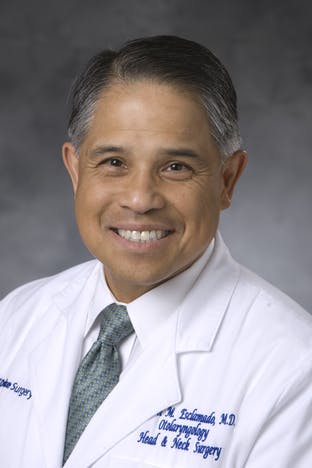Review of Partial Laryngectomy Techniques and Demonstration of the Supracricoid Laryngectomy with Cricohyodoepiglottopexy (Cadaver)
Main Text
Table of Contents
This article reviews partial laryngectomy techniques—supraglottic laryngectomy, supracricoid partial laryngectomy with cricohyoidopexy (CHP), and cricohyoidoepiglottopexy (CHEP)—as organ-preserving alternatives to total laryngectomy for select glottic and supraglottic malignancies. It highlights indications, contraindications, and surgical steps demonstrated during a cadaver dissection. Emphasis is placed on preserving laryngeal function, evaluating pulmonary reserve, and understanding anatomic landmarks critical to successful resection and reconstruction.
Partial laryngectomy, with its roots tracing back to the early 19th century, has evolved over time as an alternative operative approach for a select group of patients with glottic and supraglottic malignancies. The goal was to preserve speech and swallowing without committing to a permanent tracheostomy. The development of various techniques, such as open supraglottic laryngectomy and supracricoid partial laryngectomy, marked significant milestones in this field, significantly reducing the morbidity associated with total laryngectomy.1
In this video, in the context of a cadaver dissection course held at Duke University, the techniques for partial laryngectomy are demonstrated. The initial segment of this video focuses on explaining the two types of laryngeal surgeries: supraglottic laryngectomy and supracricoid laryngectomy with cricohyodopexy, or cricohyodoepiglottopexy (CHEP).
Although these surgeries aim to preserve the functionality of the larynx, performing them may impact voice, swallowing, and airway protection. Choosing eligible patients is critical because chronic aspiration can result in pulmonary complications for individuals whose baseline pulmonary function is affected by smoking, age, and comorbidities.2 It is likewise essential to evaluate pulmonary function, emphasizing the patient's ability to effectively engage in respiratory activities. Several alterations in lung function characterize the postlaryngectomy state. A reliable estimation of lung function can be instrumental in laryngectomy to prevent postoperative complications.3
As shown in the video, in the dissection procedure, the initial step involves making an incision at the top of the thyroid cartilage. Subsequently, the omohyoid and thyrohyoid muscles are carefully cut. To facilitate the dissection, the tissue is elevated, ensuring preservation of the hyoid bone by avoiding incisions into the suprahyoid muscles. It is emphasized that cutting the suprahyoid muscles could lead to devascularization of the hyoid structure. Subsequently, the thyrohyoid muscle is divided, with attention given to avoiding damage to the superior laryngeal nerve. Unintentional nerve injury can reduce pharyngeal sensitivity and lead to the loss of cough reflex.4,5
The video provides an explanation of supraglottic laryngectomy. The conventional open supraglottic laryngectomy is intended to remove tumors limited to the supraglottis without extension beyond the laryngeal ventricle or affecting the glottic larynx. During supraglottic laryngectomy, it is possible to include the hyoid bone and extend the procedure to involve parts of the tongue base. However, it is essential to note that this extension raises the risk of postoperative aspiration. Supraglottic cancer exhibits distinct behavior compared to primary glottic tumors. Due to the distinct embryologic origin of the supraglottis compared to the glottis, it was commonly believed for a long time that supraglottic cancers only affect the supraglottis. This has been disproven.6 Supraglottic cancers typically stay confined to the supraglottis until later stages, when they may spread to the paraglottic area or ventricular mucosa, allowing them to extend beyond the supraglottis and cause vocal cord fixation. The majority of such malignancies exhibit pushing rather than infiltrating borders, which facilitates the use of narrow resection margins. When conducting a supraglottic laryngectomy, it is crucial to identify the anterior commissure using anatomical landmarks specific to each gender. For males, the incision is performed above the midpoint between the notch and the top of the cricothyroid membrane, whereas for females, it is made approximately two-thirds of the way up. Precautions are taken to avoid descending too far to prevent complications with Broyles' ligament. The following steps include removing constrictors, controlling neurovascular cartilage, and performing incisions to preserve the hyoid. It is then resuspended with several Prolene sutures submucosally, from hyoid to thyroid. Additionally, the possibility of a cricopharyngeal myotomy is discussed, although its application is still debated due to concerns regarding reflux. An important contraindication to this surgery is the extension of lesions to the glottic level, as the approach does not allow addressing them properly. Lesions located within a distance of 5 mm from the anterior commissure are considered to be contraindications for performing supraglottic laryngectomies.
The next chapter focuses on supracricoid partial laryngectomy with cricohyoidoepiglottopexy (SCPL-CHEP), a horizontal partial laryngectomy operation for glottic cancer management in selected patients. The operation involves the removal of both the true and false vocal cords, both paraglottic spaces, the petiole of the epiglottis, and the thyroid cartilage. The SCPL is tailored for supraglottic tumors that spread to the glottis or glottic tumors projecting up to 1 cm into the subglottic region anteriorly, with a limitation of 5 mm posteriorly due to the elevated position of the joint, situated approximately 3 mm below the posterior part of the cord. Preservation of the cricoid is crucial, and the literature suggests the possibility of excising one arytenoid, provided the joint remains functional. The CHEP refers to the reconstruction performed by suturing the cricoid to the hyoid and the remnant of the epiglottis. Glottic tumors that cause arytenoid fixation or invade the posterior commissure are not amenable to SCPL-CHEP.
The other open partial surgical alternative for glottic extension of supraglottic carcinoma is supracricoid laryngectomy with cricohyoidopexy (SCPL-CHP). Although it involves a more thorough resection that removes the entire epiglottis and the preepiglottic space, it is comparable to CHEP. The cricoid cartilage and hyoid bone must be preserved in order to perform the reconstruction, which uses suturing techniques to position these structures against each other. SCPL-CHP, as reported by Laccourreye et al, demonstrated high tumor control rates with no local recurrence in 68 patients, particularly in carefully selected T2 and T3 stage cases. For patients with preepiglottic invasion, a 94% local control rate was observed in 19 patients. Similarly, remarkable results for local control (3.3% recurrence) were reported by Chevalier et al for supraglottic cancer managed with supracricoid laryngectomy with cricohyoidopexy. The procedure proves successful in selected cases by addressing potential pathways of tumor spread, such as paraglottic spaces. However, temporary dysphagia and tracheostomy may occur in terms of functional outcomes.6
For both supraglottic and supracricoid laryngectomies, efforts are made to preserve the hyoid. The decision to excise the hyoid and a portion of the tongue base as a margin in a supraglottic laryngectomy depends on the tumor's proximity to the hyoepiglottic ligament. In the case of supracricoid laryngectomy, the ability to save the hyoid is pivotal, and any extension should be approached cautiously. Contraindications include T4a tumors extending through the thyroid cartilage, with extralaryngeal spread, anterior extension beyond 1 cm, involvement of the interarytenoid area, compromising pulmonary function, and with fixation of the cricoarytenoid joint.
The final part of the video details the fixation process following tumor excision. Initially, the larynx is released, and a plane is developed in the anterior midline to pull the trachea up. Two 2-0 Prolene permanent sutures are utilized for fixation; the first is placed submucosally around the cricoid in the midline, and the second is placed around the hyoid, tongue base, and back. Subsequently, additional sutures are placed 8–10 mm apart, securing the larynx in the desired position. An additional stitch to the cricoid is employed through the vocal process, creating a T-shaped configuration. This maneuver is aimed at opposing the movement of the arytenoid, providing a stabilizing effect. The final step involves elevating the pyriform sinus mucosa by placing a couple of stitches on one side, and reapproximating it to the other side. This helps bring the anterior wall of the pyriform sinus forward and recreates its appearance. After that, the trachea is lowered, and a surgical dressing and Penrose drain are applied.
Supraglottic laryngectomy, SCPL-CHEP, and SCPL-CHP offer practical alternatives to total laryngectomy (TL). These organ preservation surgical techniques are useful for laryngeal lesions that have outlived the traditional indications. This video serves as a valuable resource, providing a comprehensive demonstration of these surgical processes on a cadaver, accompanied by insights from the practitioner. This presentation enhances understanding and proficiency in these advanced procedures, providing a practical guide for medical professionals.
Dr. Scott Brown serves as a section editor at JOMI and has not been involved in the editorial processing of this article.
Abstract added post-publication on 07/31/2025 to meet indexing and accessibility requirements. No changes were made to the article content.
References
- Thomas L, Drinnan M, Natesh B, Mehanna H, Jones T, Paleri V. Open conservation partial laryngectomy for laryngeal cancer: a systematic review of English language literature. Cancer Treat Rev. 2012;38(3). doi:10.1016/j.ctrv.2011.05.010.
- Cash H, Meyer TK, Rizvi ZH. The role of pulmonary function testing prior to partial laryngeal surgery. Laryngoscope. 2023;133(7). doi:10.1002/lary.30671.
- Castro MA, Dedivitis RA, Salge JM, Matos LL, Cernea CR. Evaluation of lung function in patients submitted to total laryngectomy. Braz J Otorhinolaryngol. 2019;85(5). doi:10.1016/j.bjorl.2018.05.008.
- Kiray A, Naderi S, Ergur I, Korman E. Surgical anatomy of the internal branch of the superior laryngeal nerve. Eur Spine J. 2006;15(9). doi:10.1007/s00586-005-0006-7.
- Ricci Maccarini A, Stacchini M, Salsi D, Padovani D, Pieri F, Casolino D. Surgical rehabilitation of dysphagia after partial laryngectomy. Acta Otorhinolaryngol Ital. 2007;27(6).
- Laccourreye H, Laccourreye O, Weinstein G, Menard M, Brasnu D. Supracricoid laryngectomy with cricohyoidopexy: a partial laryngeal procedure for selected supraglottic and transglottic carcinomas. Laryngoscope. 1990;100(7). doi:10.1288/00005537-199007000-00009.
Cite this article
Brown CS, Esclamado RM. Review of partial laryngectomy techniques and demonstration of the supracricoid laryngectomy with cricohyodoepiglottopexy (cadaver). J Med Insight. 2024;2024(213). doi:10.24296/jomi/213.


